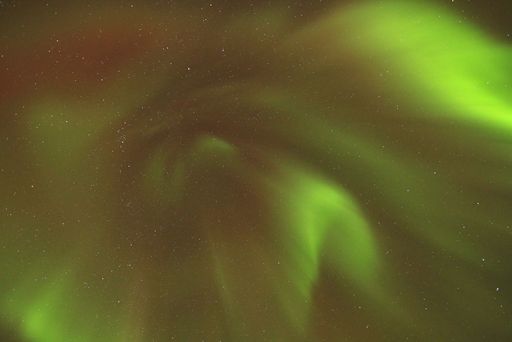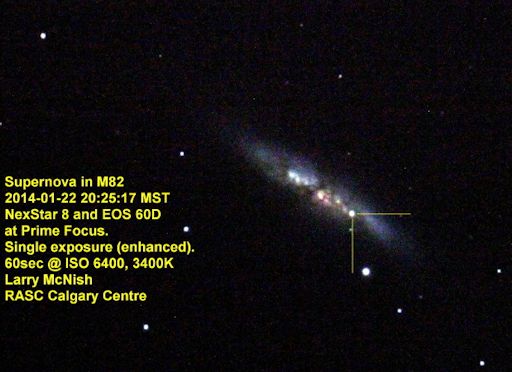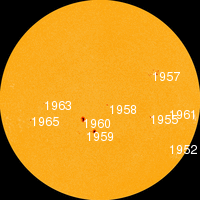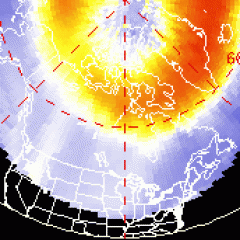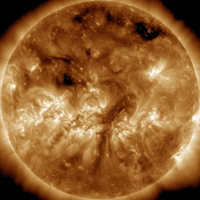~Space Weather Update~MOSTLY QUIET WITH A CHANCE OF FLARES [1]
MOSTLY QUIET WITH A CHANCE OF FLARES: With no sunspots actively flaring, solar activity is low. However, sunspots AR1957 and AR1959 could break the quiet. Both regions have 'beta-gamma' magnetic fields that harbor energy for medium-sized eruptions. NOAA forecasters estimate a 15% chance of M-class [2] flares on Jan. 24th. Solar flare alerts: text [3], voice [4]
NO CME, NO PROBLEM: A CME expected by forecasters to deliver a glancing blow to Earth's magnetic field on Jan. 23rd missed our planet. Arctic sky watchers got an eye-full anyway. Dennis Ball sends this picture of colors erupting last night over Bolungarvik, Iceland:
"After a day of horrid weather, the clouds parted at 9 PM and I grabbed by camera to photograph the auroras," says Ball. "By 10.30 PM the clouds had rolled in again, so I got an early night. It was an excellent start to my Iceland trip."
The source of the display was not a CME, but rather a fluctuation in the interplanetary magnetic field or "IMF [6]." On Jan. 23rd, the IMF tilted south for a few hours, opening a crack [7] in Earth's magnetosphere. Solar wind poured in to fuel the auroras.
Realtime Aurora Photo Gallery [8]
SUPERNOVA! Approximately 12 million years ago, a white dwarf star in the galaxy M82 [9] exploded. This week, light from the distant supernova finally reached Earth. Amateur astronomers can see it through backyard telescopes as a fireball of magnitude +11.2 in one of the galaxy's dusty spiral arms. Here is the view through an 8-inch telescope on Jan. 22nd:
Larry McNish took the picture from the University of Calgary's Rothney Astrophysical Observatory in Alberta, Canada. "I used a Canon 60D DSLR at the prime focus of an 8 inch Celestron SCT telescope," he says. "This is just a single exposure of 60 seconds at ISO 6400 using a white balance of 3400K to reduce the sodium sky glow from Calgary."
Although it is 12 million light years away, M82 is considered to be a next-door neighbor of the Milky Way. Indeed, this is the nearest supernova to Earth since SN 1993J [11] was famously observed 21 years ago. The relative proximity of the blast makes it an attractive target for astronomers to study. Light curves from previous supernovas of this type [12] suggest that the fireball could continue to brighten for the next two weeks.
If you have a GOTO telescope, this evening command it to slew to the "cigar galaxy" or "M82," and watch the explosion unfold.

Solar wind
speed: 367.2 km/sec
density: 2.1 protons/cm3
explanation [13] | more data [14]
Updated: Today at 1646 UT
X-ray Solar Flares
6-hr max: B9 1037 UT Jan24
24-hr: B9 1037 UT Jan24
explanation [15] | more data [16]
Updated: Today at: 1600 UT
![]()
Daily Sun: 24 Jan 14
Sunspots AR1957 and AR1959 have 'beta-gamma' magnetic fields that harbor energy for M-class [2] solar flares. Credit: SDO/HMI
![]()
Sunspot number: 121
What is the sunspot number? [18]
Updated 24 Jan 2014
Spotless Days
Current Stretch: 0 days
2014 total: 0 days (0%)
2013 total: 0 days (0%)
2012 total: 0 days (0%)
2011 total: 2 days (<1%)
2010 total: 51 days (14%)
2009 total: 260 days (71%)
Update 24 Jan 2014
The Radio Sun
10.7 cm flux: 136 sfu
explanation [19] | more data [20]
Updated 24 Jan 2014
![]()
Current Auroral Oval:
Switch to: Europe, USA, New Zealand, Antarctica
Credit: NOAA/POES
![]()
Planetary K-index
Now: Kp= 1 quiet
24-hr max: Kp= 3 quiet
explanation [22] | more data [23]
Interplanetary Mag. Field
Btotal: 6.3 nT
Bz: 2.0 nT north
explanation [24] | more data [25]
Updated: Today at 1646 UT
![]()
Coronal Holes: 24 Jan 14
There are no large coronal holes on the Earthside of the sun. Credit: SDO/AIA.
